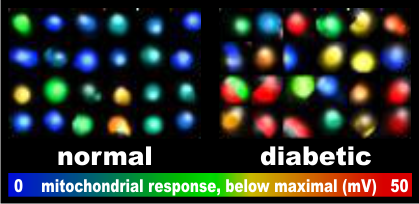An imbalance of
cellular bioenergetics in pancreatic beta-cells is linked to type 2
diabetes
 |
| The illustration shows individual pancreatic beta-cells from a patient with type 2 diabetes and a patient without the disease. Cells were visualized by artificially coloring their fluorescence image according to the deficit in the response of their mitochondria to glucose. Warmer colors show a larger deficit, indicating how much more response is possible when intracellular energy demand is experimentally shut off. Beta-cells from each of the observed type 2 diabetic donors underperformed beta-cells from normal donors in this respect. Interestingly, the maximal possible response in the absence of intracellular energy demand was not impaired, demonstrating that the mitochondrial polarization and downstream insulin secretion is determined by the supply-demand balance of the intracellular energetics in whole. |
Novato, CA/July
28, 2015:
Impaired
activation of mitochondrial energy metabolism in the presence of glucose
has been demonstrated in pancreatic beta-cells from patients with type 2
diabetes. The cause of this
dysfunction has been unknown.
Publishing online in
Endocrinology, Buck Institute assistant research professor Akos
Gerencser, PhD, shows that in patients with type 2 diabetes the balance
between supply and demand of the mitochondrial membrane potential
(ΔψM) is altered causing a decrease in the
signaling that turns on insulin secretion.
Gerencser said the altered balance makes the
beta-cells from the patients with type 2 diabetes perform like an
economy car – as opposed to a full-size vehicle. “Both cars will do fine
on a level freeway, but the economy car will respond more sluggishly
when you press the gas, and will fall behind on an uphill road,” he
said. “An increase in blood sugar is the equivalent to stepping on the
gas, the
ΔψM is the RPM of
the engine, and the response makes for a real-life uphill road.”
Gerencser said.
Gerencser utilized new fluorescence
microscopic assays to quantify
ΔψM and its response to glucose in
pancreatic beta-cells from four normal and three type 2 diabetic organ
donors. Observation of
individual cells under the microscope allowed simultaneous recording of
ΔψM and plasma membrane potential – a mediator of insulin secretion
– while the supply or the demand in cellular energy metabolism was
altered.
His findings suggest that the
failure of pancreatic beta-cells to secrete sufficient amounts of
insulin in patients with type 2 diabetes may be explained by the
cellular level disturbance of energy metabolism, a process whereby
multiple supply and demand pathways interplay in a complex network of
metabolic reactions. The research showed that mitochondrial energy
metabolism did not harbor a substantial defect, but that a more subtle
disharmony between bioenergetic supply and demand pathways dampened the
response to glucose in the observed individuals. “Type 2 diabetes is a
multi-etiological disease,” Gerencser said. “The demonstration of a
cellular systems-level dysfunction of energy metabolism suggests that a
shift towards systems-level approaches is needed to fight the disease.”
The current reductionist paradigm is aimed at understanding type 2
diabetes on a molecular level, he said.
Dr. Gerencser designed and utilized the novel
fluorescence microscopic assays to quantify
ΔψM and its
response to glucose in single pancreatic beta-cells from normal and type
2 diabetic organ donors. Determination of the absolute magnitude of
ΔψM that is required for the comparison of
diseased and
normal individuals has been previously unattainable due to fundamental
biophysical processes interfering with the readout of otherwise commonly
used fluorescence sensor molecules. The novel assay technology enables
researchers to untwine these interfering factors and to interpret
fluorescence signals correctly as millivolt potentials. The previously
published (J Physiology 2012
590:2845-71)
technology became practical when it was implemented into Image Analyst
MKII (Image Analyst Software, Novato, CA), a fluorescence time-lapse
microscopy analysis and assay software. This allowed unbiased comparison
of
ΔψM and its
response to experimental interventions in thousands of individual cells
in minuscule pancreatic samples from human organ donors.
“I hope
these findings and the newly introduced technology will prompt others to
seek a better understanding of the systems-level regulation of cellular
energy metabolism,” said Gerencser, “My goal is to help reveal
etiologies that may affect this central mediator of insulin secretion in
human type 2 diabetes.”
###
Citation:
Endocrinology:
Bioenergetic Analysis of Single Pancreatic Beta-Cells
Indicates an Impaired Metabolic Signature in Type 2 Diabetes Subjects
FINANCIAL DISCLOSURE: Dr. Gerencser has
developed Image Analyst MKII and is the founder of Image Analyst
Software.